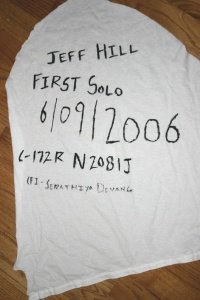| Lesson 20 | |
| Flight time logged: | 1.9 hours |
| Total flight time logged: | 30.3 hours |
| Total takeoffs/landings: | 113 |
| Solo time: | 1.5 hours |
| Total time solo: | 3.1 hours |
| Total cost to date: | $4960 |
It's been some time since my last blog entry. I had to take a couple weeks off from my lessons to finish up a project at work. It turns out that the weather was not that great anyway, so I did not miss much flying time. I was ready to get back up in the air, though.
Last week we were continuously getting isolated severe thunderstorms that would appear in the middle of the afternoon almost daily. Finally, towards the end of the week, the forecast for Sunday and Monday was looking promising. I signed up for three hours of time on Monday morning hoping for good weather. On Sunday, I started planning my cross-country to Baldwin County airport in Milledgeville.I arrived at the airport at 9:30 AM this morning to finish by planning by gathering the winds aloft forecast and preparing to file my flight plan. The winds aloft were very light today. My instructor was off helping another instructor pick up an airplane from another airport. He called me at 10:00 AM to tell me that he would be late. I waited patiently until he arrived an hour later. We went over the flight plan; I filed the plan with the flight service station over the phone; then went off to perform the pre-flight on the airplane. I had to take 6CP again because 81J was out for maintenance on the starter.
I had filed my departure time as 11:45 AM (15:45Z), but did not take off until 12:20 PM (16:20Z). Upon leaving the airspace, we radioed Macon FSS to activate the flight plan. I had planned to climb to a cruising altitude of 5500 feet MSL, but the standard briefing had mentioned a few cumulus clouds with bases at 3500 feet AGL. Once I climbed to 4500 feet MSL, the few cumulus clouds just happened to be right in my path. In order to avoid going through one of the clouds, I had to descend back down to 3500 feet AGL. I ended up cruising at 3500 feet AGL the remainder of the flight down to MLJ.
I was amazed by how accurate I was tracking the planned course. I hit the checkpoints almost dead on the time I expected. Typically I would either be a minute ahead or a minute behind. It all balanced out in the end. I was also amazed by how fast we made it to the destination. It was going to be a 35 minute flight, but it went by quickly. After I passed by last checkpoint, I had the airport in site, made my calls, entered the pattern, then landed on Runway 28. Baldwin County airport is a really scenic place because it is on Lake Sinclair. You fly over the lake to land on Runway 28.
After landing, I changed out my nav log for the return trip and prepared for the flight back to LZU. I taxied out to Runway 28, took off, and headed back towards LZU. I had power lines off to the left of my course, so I used them as a ground reference to keep me on track. My return cruising altitude was 4500 feet MSL.
On the way back, I requested flight following. My instructor wanted to show me how to use flight following. Basically, you're asking air traffic control to watch you on their radar and give you traffic updates. It was interesting trying to listen to two different radios at the same time.
Before long, I was within 10 miles of LZU. My flight following was terminated once I had the airport in site. I contacted the tower to request a full stop landing. I was cleared to enter on a five mile right base and then to land.
After tying down the plane, we walked back inside the office and talked about the flight. My instructor complimented me on keeping on the course and on my landings. I was surprised myself since it has been three weeks since I've last flown. I figured I would be rusty.
I decided that I wanted to do another short cross-country to get more practice with the instructor in the airplane with me. My instructor asked by to prepare a short cross-country to the northeast.
I'm scheduled to fly again on Friday morning. I'm going to stay in the practice area this time and practice ground reference maneuvers, stalls, and steep turns since it's been a month or so since my last practice. Hopefully, I will not be rusty. It's nice to be flying again.



